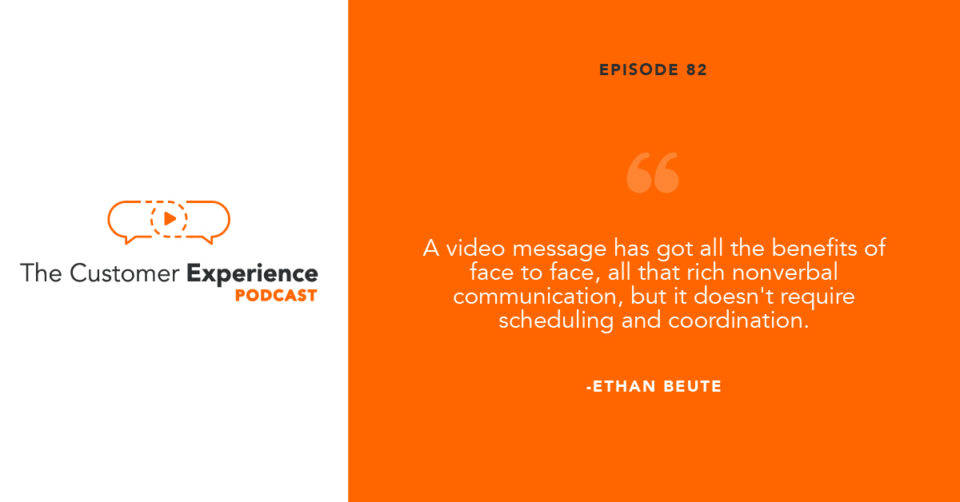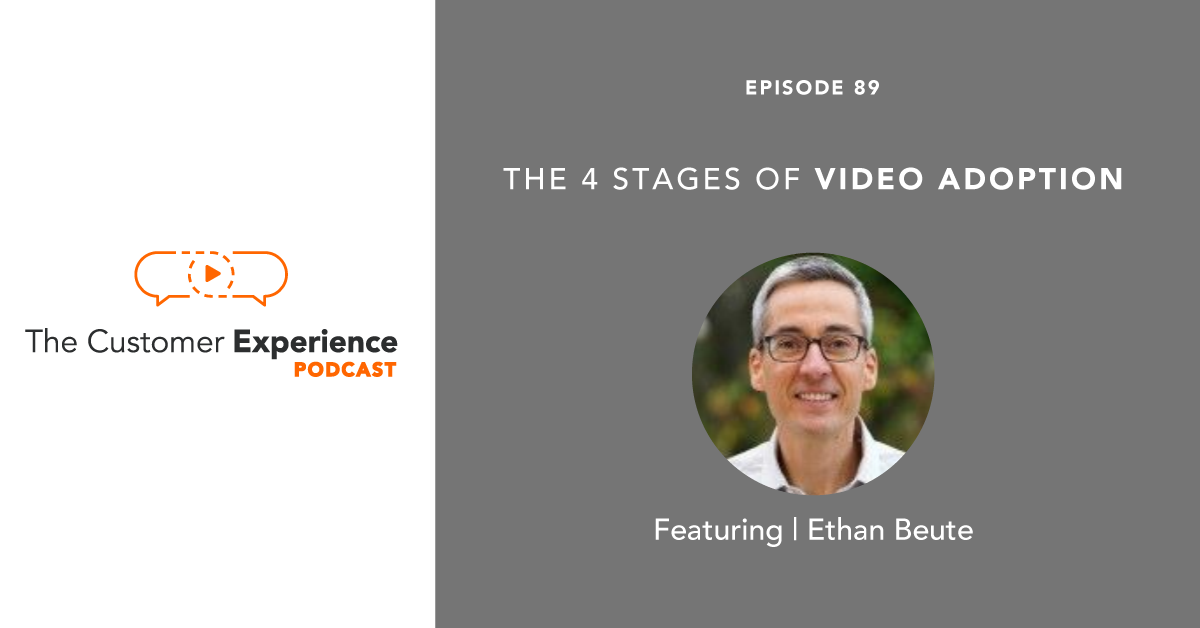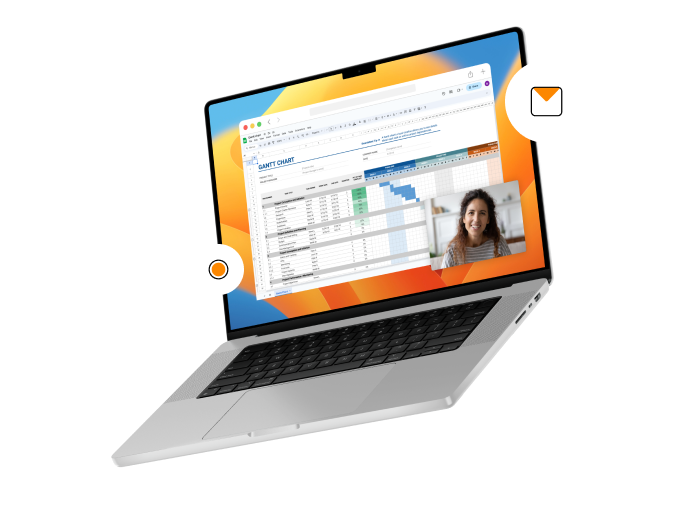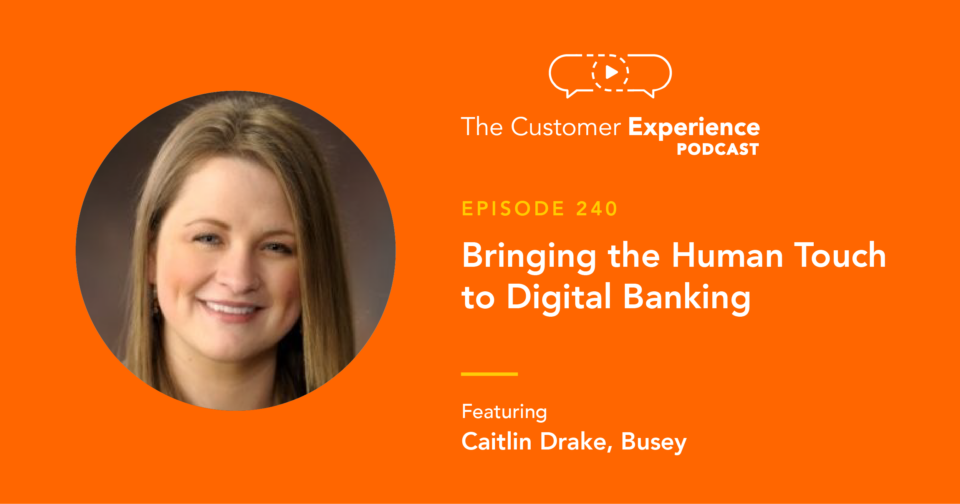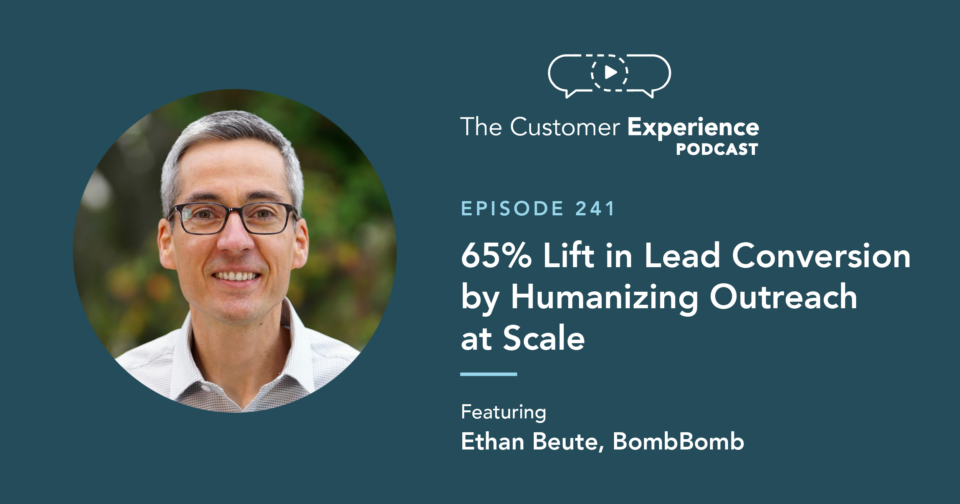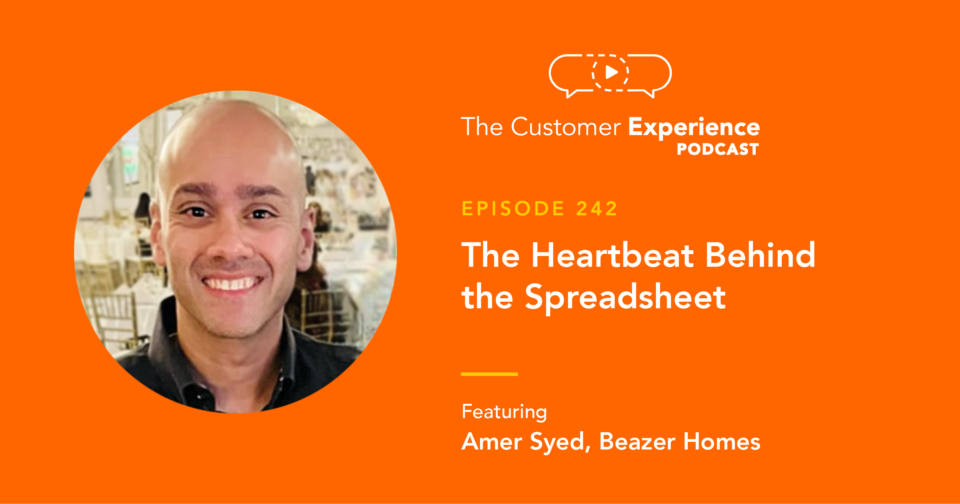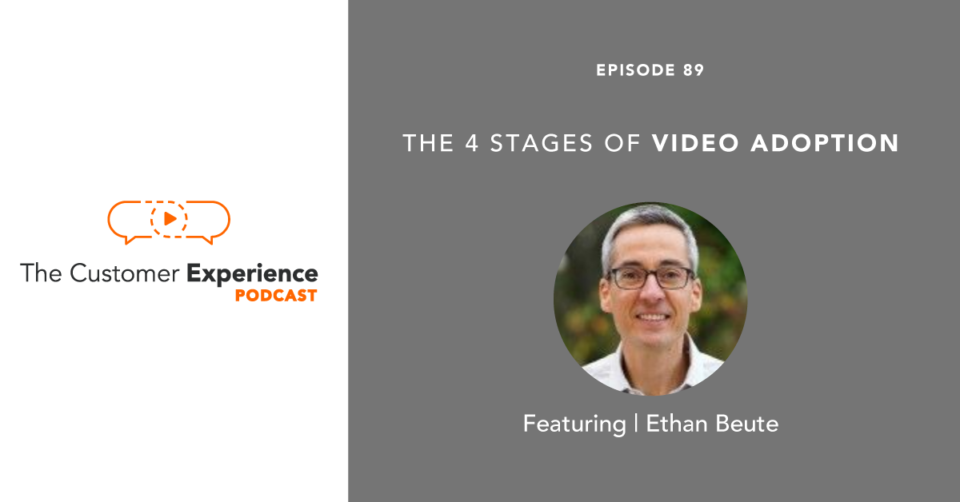
Listen to “89. The 4 Stages of Video Adoption w/ Ethan Beute” on Spreaker.
Apple Podcasts | Google Podcasts | Stitcher | Spotify
Your people are what sets your organization apart. Your corporate brand is built in part through the personal brands of your team members. Your customers most memorable moments are often based in human interactions with your company.
So how do you showcase people? How do you deliver an exceptional customer experience? One way: get your team face to face more often through video messages.
But how do you get started? What are the best practices that can help you and your team see results? How to you close the gap between a good idea and a healthy, new habit?
Through years of helping tens of thousands of people adopt video messaging, we’ve observed that every one of them had to go through the same four stages of video adoption for successful video implementation.
Understanding these stages will help clarify and smooth the video adoption process. They include…
• Stage 1: Script – What to say and when to say it
• Stage 2: Self – Comfort and confidence on camera
• Stage 3: Structure – Best practices for using text and video together
• Stage 4: System – Making video a process and habit
I carefully researched and crafted a fully comprehensive Video Messaging Adoption Guide around these four stages. This episode of The Customer Experience Podcast offers a quick overview of The Four Stages of Video Adoption.
I’m Ethan Beute, Chief Evangelist at BombBomb, coauthor of Rehumanize Your Business, host of The Customer Experience Podcast, and host of the #CX series on B2B Growth, here to share what I’ve learned about video messaging adoption from years of working with the BombBomb team and community.
In this episode, you’ll learn…
• What The Four Stages of Video Adoption consist of
• How to overcome the discomfort of seeing yourself on video
• What things people say when they’ve adopted video successfully
• What it looks like in your organization when sending videos is normalized behavior
The 4 Stages of Video Adoption
Please give this one a listen and reach out with feedback!
Hear the entire episode right here:
Listen to “89. The 4 Stages of Video Adoption w/ Ethan Beute” on Spreaker.
Prefer to listen in your preferred podcast player?
Subscribe, listen, rate, and review The Customer Experience Podcast here:
Sign up for a monthly email with CX insights and highlights
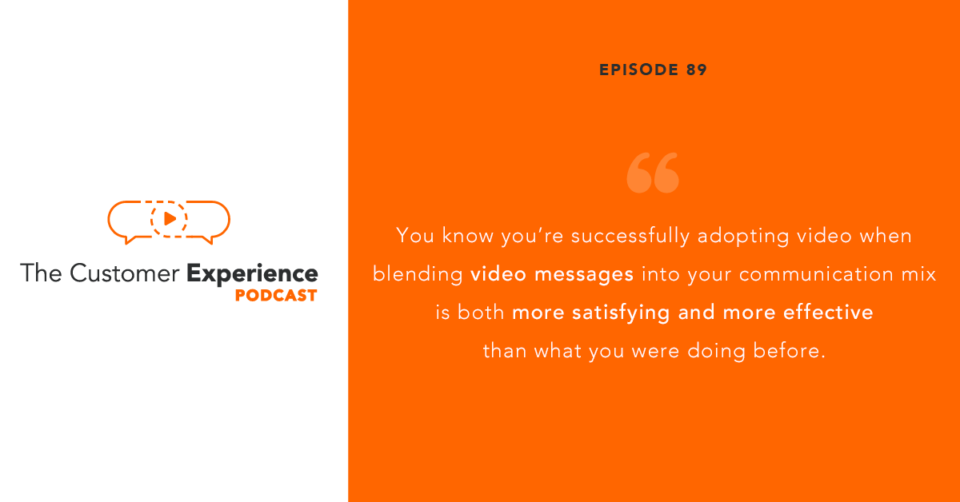
Full Transcript: The 4 Stages of Video Adoption
Ethan Beute:
If you believe that your people are your organization’s strongest asset if you think that you and your team members should be more visible to your customers, if you want to deliver a truly remarkable customer experience, if you feel that successful selling involves the transfer of emotion, if you recognize that people connect and communicate far more effectively in person than they do in typed out text, then you are in the right place. My name is Ethan Beute. I am host of the Customer Experience Podcast and of the CX Series on B2B growth. I’m also chief evangelist at BombBomb and co-author of Rehumanize Your Business. What I’ve got for you here today is an introductory framework to the successful adoption of video messages within your organization or within your daily process.
Ethan Beute:
There are four stages of adoption that lead to the success of individuals and teams in this change management process in the adoption of a new way to connect and communicate of blending some video messages in, along with your Zoom calls, along with your emails, along with your phone calls, along with your LinkedIn messages, along with your direct mail or the mailing of gifts to people. When you look at all of the messages and all of the touchpoints that make up your customer’s experience, there are so many spots in which being a little bit more personal, a little bit more human, a little bit more clear, a little bit more relationship-oriented all through video will be a huge value to you, to your team members, and to the people you’re connecting with, selling to, and serving, hopefully in a longterm, growing relationship.
Ethan Beute:
What I’ll do here is share what successful adoption of video looks like and a brief introduction to the four stages of adoption. Now, I’ve written a piece on this. It’s over 20,000 words long. It’s far too big for this podcast episode. I want to introduce the stages so that you can have some understanding of what a normal experience is as you start mixing videos in with all of the other ways that you’re communicating with people. Here are a few things that will let you know that you’re successfully adopting or have successfully adopted video messaging as part of the way that you and your team do business.
Ethan Beute:
Most of your team is sending several videos each day or each week, based on specific triggers, time blocking, and/or automation. Most of the team is using video pretty consistently with some clear intention. Next, the motivations for an execution of video messaging are aligned with individual, team, and company goals. Getting this alignment is really, really key. Individuals won’t adopt if the motivations for using video are very specifically anchored in company goals and not the individual’s goals. Same thing at the team level. It needs to work across all three levels. It needs to make sense up and down the organization for people to successfully adopt it and produce real outcomes for your team and for your business.
Ethan Beute:
Next, you’re generating hours of face to face time through video that would be hard to achieve any other way. You and your team are getting face to face with people earlier, more often, and at scale by sending video messages when it’s convenient for you and having people have that face to face time with you and your team members at their convenience. We have leaders and managers, sales reps, CSMs, account managers, and other people who are generating well over 40 hours of face time in a given week, even though they’re only sending a couple total hours of video content out to the people who matter most to their success.
Ethan Beute:
Next, best practices are being shared and coaching is being provided for constant iteration in where, when, and how you’re communicating with video messages. There’s going to be some prescription of the where, when, and how for team members. They’re going to be executing it, but it’s an iterative process. We need to make sure we’re paying attention to what’s working best and how we can all get better together. You’re telling success stories and teaching use cases internally, and if you’re working with BombBomb, with the support of our team, as video becomes normalized within your processes and your culture. This reinforcement with examples and success stories, specific ways to use it, and successes tied to those use cases are so key to making sure adoption spreads throughout the entire team or throughout the entire organization.
Ethan Beute:
You know you’re successfully adapting when it becomes obvious to you and obvious to your team that blending video messages into your communication mix is both more satisfying and more effective than what you were doing before. You’re going to be getting replies and responses. You’re going to be hearing stories. You’re going to be getting outcomes and results that let you know that this is different and better, and that’s key to creating that momentum to really turn new practices into solid habits.
Ethan Beute:
Finally here, recording and sending video messages is normalized behavior, and you can’t imagine working without it. We’re working with tens of thousands of people in all kinds of roles, in all kinds of industries and businesses. It’s always a pleasure to hear from people who say, “I can’t imagine what life was like before this, and I don’t want to go back. I’m saving time. I’m building better relationships. I’m getting more yeses. I’m staying face to face. I’m getting face to face earlier and more often with people.” Those are some of the things that you hear when people have successfully adapted video.
Ethan Beute:
What stages do you have to go through? You have to go through four stages, and you’re going to be working through stages one, two, and three simultaneously, and you’re going to be working through them from the very start. Stage four is where we take what we’ve learned and developed in stages one, two, and three, and fully adopt and truly expand the use of video by individual and by team. Now, progress through these stages is completely personal. Each person has different strengths and experiences, and they’re going to move through these stages at different paces.
Ethan Beute:
None of these stages though are optional. Adoption and success require basic competence in all four of these stages. Last thing before I share the stages and a little bit about them, practice is absolutely key. The more videos you send, the more attuned you become to the importance and nuance of each stage. Stage one, script. Stage two, self. Stage three, structure. Finally, stage four, system. Script, self, structure, and system. Again, as you start using videos in place of some of your typed out text, you’ll be working on script, self, and structure simultaneously. Once you have a solid foundation there, you will start to systemize what you’re doing and what your team members are doing.
Ethan Beute:
Stage one, script. This is what to say and when to say it. When would I actually use video? When is video better than plain typed out text. This is use cases, and I always recommend starting with one or two use cases and then growing into additional opportunities beyond that. A couple things to keep in mind here with script. You can use video across the entire customer life cycle in the earliest stages of a prospect or customer relationship, whether you’re generating inbound or outbound opportunities. You have some spots there where you can use video to generate a higher response rate or to have people feel like they know you before they meet you.
Ethan Beute:
Obviously, as you’re nurturing and educating, you’re maybe coming up against competitors, you’re looking to set and hold appointments, you’re looking ultimately to present a contract or present a proposal and have it taken up, all of those touchpoints are opportunities to use video to communicate more clearly, connect with people more effectively, and ultimately get more yeses. Of course, once someone has committed to your product or service, you need to onboard them into the service. You need to generate an impact or an outcome or that initial result that lets them know they made the right decision. Of course, you want to ultimately create that positive growth loop, where people are expanding their purchasing, renewing their purchasing, bringing more people on, referring you, giving you online reviews and testimonials, growth and advocacy in the customer, and in the customer account. That’s what we all want.
Ethan Beute:
Of course, there’s an employee life cycle that mirrors that entire customer life cycle. It’s the same thing. A potential employee needs to know that you exist, what opportunity is there? Who are you and what are you about? Are you the employer of choice for me and in the area? What are the terms of the agreement? Am I being onboarded successfully? Am I getting what I wanted out of the job, and are you getting what you wanted out of the hire? Am I a longterm growth potential where I’m getting promotions, I’m adding value to the organization, I’m bringing other great employees along, I’m a great add to the culture, and ultimately I am this brand advocate while being an operator inside the business? That’s what we want from employees, and we can use video across that life cycle as well. So, there are a number of use cases.
Ethan Beute:
I did a separate episode with three specific characteristics to look forward to know that that touchpoint is a great place to add video in place of text. If you visit bombbomb.com/podcast, again, that’s bombbomb.com/podcast, you can see that episode and many others. I will link up to it right here in the blog post for this episode in particular. For reference, that’s episode 52, Video belongs in these three moments in your customer journey. Equally, it applies to the employee journey or employee life cycle as well. That’s episode 52 of the customer Experience Podcast at bombbomb.com/podcast or in your preferred player.
Ethan Beute:
To button up stage one, script, I should add that you don’t need a script. All of these messages are whatever you would say if you were leaving a voicemail or whatever you would say if you were in front of the person. So much of our communication is about how we say it, not just what we say. Don’t beat yourself up over minor misstatements, and pauses, and those types of things. Don’t read a script off a piece of paper or off your screen. The goal here is to be yourself and to communicate in a more human way. I should also conclude this by adding that any time you are clicking send or a machine is sending a message out on your behalf is a chance to add a video, to bring the message to life, and to generate better results across the customer life cycle, across the employee life cycle, and even within your personal and professional networks. Stage one is script, what to say and when to say it.
Ethan Beute:
Stage two is self, comfort, and confidence on camera. Why is that second when it’s one of the biggest pain points for people trying to adapt video? It’s because you have to know when you’re going to send video, when you might actually use it, why you should do it before you actually turn the camera on and say to yourself, “I don’t know if I can do this,” but that is an experience that everyone has. The reason we draw this out as specific stage is that it is one of the biggest hurdles and impediments people experience in the adoption of video. They have all the best motivation. They’re totally bought in on the why. They have some specific use cases, but they see themselves or hear themselves in a video and they think, “I can’t do this. I’m not good enough. This video isn’t good enough. My equipment isn’t good enough. I misspoke. I didn’t do it the right way.”
Ethan Beute:
Here’s the bottom line here. You’ve successfully adopted video when you’re no longer thinking about recording video, you’re just doing it. Whether you’re in a public space or whether you’re in a private space, closed in your office or your home office, when recording a video is just a normal activity and you’re out of your own head, you’re well on your way to having video be a habit for you. Here’s the deal. If you’re listening to a podcast like this, you are a smart, competent, worthy professional. You may get a little nervous or excited before a big moment or a big meeting, but most of the time you’re not especially self-conscious on the phone, or in person, or in your digital communication. But somehow when the record light comes on, everything changes. Right? You’re not sure if you’re doing it right. You second guess everything. You start judging yourself harshly moment by moment, as you play the video back. You get hung up on every pause or every um.
Ethan Beute:
Just know that this will pass. This is where almost everybody starts. Very, very few people are comfortable right out of the gate. Fortunately for you, because of Zoom and the need to do for video calls more often, you’re probably a little bit more comfortable seeing yourself on the screen. You’re probably a little bit more comfortable with your setup wherever you are, in your office, or your home office. You’re probably comfortable with the scene, and the setting, and the lighting a little bit, but there are still some hurdles that you have to getting comfortable recording video messages. Again, the only reason you’re hung up on it is that you can play it back. That’s a good key here. Don’t watch your videos back. Just send them and let the positive feedback loop let you know that this is in fact a different and better way to work.
Ethan Beute:
It’s perfectly normal to feel awkward. It’s perfectly normal to feel uncomfortable. It’s perfectly normal to lack a little bit of confidence when you’re getting started. There’s a bit of vulnerability that you have to work through here, but just keep in mind that all of the best moments of your life are characterized by vulnerability. Brene Brown defines vulnerability as the feeling of risk, uncertainty, and emotional exposure. But when you think about your life, all of the best moments, whether it’s proposing marriage or accepting a marriage proposal, finding out you’re having a child or having your first child, going out to try to make the team or trying to set a personal best, all of these moments are characterized by risk, uncertainty, and emotional exposure. Going into a big job interview. Am I going to get the job? All of our best moments are characterized that way. I promise that a little bit of practice will get you comfortable on camera, and stage two, self, will be a checked box and you’re moving on to make progress in other areas.
Ethan Beute:
Stage three is structure. How do we use text along with video for best results? What I see so many people doing out of the gate is they record a video and they just drop it into an email, or they drop it into a LinkedIn message, or they drop it into a Facebook message, or a text message, and they just expect, because they took the time to record the video and dropped it in front of somebody, that someone is going to click play. Honestly, because we’re so early in this habit and process, a lot of people will click play, but if you want best results, you need to use text along with your video to drive the video play and to drive the ultimate call to action. There are also some other subtleties and nuances in structuring your video message.
Ethan Beute:
For example, BombBomb automatically takes the first three seconds of your video and turns it into a little animated preview. There are so many things you can do in those three seconds to take the personalization and relevance that you’ve thought about and put into the subject line and into the first line of text driving the video play that can also be reinforced in that animated preview, whether it’s drawing someone’s logo, or writing their name or a message on a whiteboard, or holding up a business card, or holding up a book that they wrote, or doing a screen capture on their LinkedIn profile or on a podcast screen that they guessed it on. Picking up best practices that already exist and doing some trial and error on your own to find the best results that you can get in terms of generating video plays and generating replies and responses or whatever your call to action may be, clicking to fill out a form, clicking to take a survey, picking up the phone and giving you a call, going ahead and clicking and buying, or subscribing, or signing up, whatever the case may be. There are ways that you can structure your video message to be more effective. That’s stage three.
Ethan Beute:
Stage, one script. What do I say, and when do I say it? Stage two, self. How do I get out of my own head and get comfortable on camera? Stage three, how do I structure my video message? How do I use text along with the video to get desired outcomes, both for me and the person I’m sending the message to? You can see how when you send your first 10, or 20, or 40 video messages, you’re working all three of those at the same time, but as you develop those muscles and get that strength there, you’re going to be moving on into stage four, which is system.
Ethan Beute:
I’ve heard this too many times. Every time I use BombBomb, I make money, but, gosh, it’s been a while since I used it. Right? What other activities are you doing? This is more personal, more human. You get more replies and responses. You get more clicks through your emails. You convert leads at a higher rate, all these other things that our customers tell us. We need to make sure that as we develop these strengths, we don’t let them atrophy, but instead, we make video a process and a habit. We make it as easy to go to as jumping on the phone or typing out an email. Not that you’re going to do any one of those activities all of the time, but that it’s just as common and just as easy to do that when the opportunity does come up to send a video, oh, it’d be great to send a video now, that you’re comfortable and confident, and equipped to do it.
Ethan Beute:
This is where adoption really, really takes hold. Some of the things that you’re doing when you’re systemizing video in this stage is taking those users cases, when am I going to send a video, when this happens, when that happens, every X number of days, or weeks, or months, these kinds of things, you’re taking the use cases and mapping them to triggers. Right? Every time this happens, my team members send a video instead of text or along with text. What types of video messages are triggered?
Ethan Beute:
Then there’s time blocking. Every Thursday afternoon I’m going to take one hour and reach out in a video message to all the people who fit these three criteria. Right? In sales, for example, it might be held a demo, but didn’t convert, or expressed some interest, but the timing wasn’t right, you know, these types of things. Post-sale you’re looking at checking in with your key accounts on a monthly basis or perhaps even a biweekly basis, staying in front of people before the quarterly business review comes around, giving updates on progress or milestones. A trigger post-sale might be someone from a key account reaching out with an important question and you realizing that responding with a video is going to be easier and more effective. Time blocking would say, I’m going to carve out time in my schedule to proactively communicate to these types of people for these types of reasons.
Ethan Beute:
Finally, there’s automation. You have triggering, time blocking, and automation. Which messages am I going to record once and use over, and over, and over again, or if I’m using a tool like Outreach, for example, which is used on the sales side and on the CS side, there’s a great BombBomb outreach integration? In addition, there’s a great BombBomb Zendesk integration, and there’s a great BombBomb Salesforce integration, but when I set up my sequences for my salespeople or for my CSMs in outreach, which messages are going to be truly automated, and which ones are going to trigger me to go record a personal video in that moment?
Ethan Beute:
Building on that, another part of systemizing video is figuring out which videos we’re going to do truly personal, truly one-to-one. Which are we going to do one to segment or one to group in a more mass situation to 50 people or, 100 people, or 500 people, or perhaps even 5,000 people all at the same time, and which videos are we going to make evergreen, where we record them once and use them over, and over, and over again, as they’re appropriate? Some cases here might be onboarding new customers or helping people in any transition from one stage to another with you and your business is a great thing to make evergreen videos for, and answers to frequently asked questions are a great basis for what is the content of those videos. That’s a snapshot of stage four, system.
Ethan Beute:
Again, those four stages are script, self, structure, and system. I’ve been working on this for years. Our team has been working on this for years. We’ve helped tens of thousands of people. We’d love to help you, too. If you have any questions at all about using video, successful adoption of video hit me up on LinkedIn. Again, my name is Ethan Beute. My last name is spelled B-E-U-T E, or you can even email me Ethan, E-T-H-A-N,@bombbomb.com. I’d love to answer your question or put you in touch with the right resource or the right person to get you where you want to go. I know that you’re going to find personal video messages a more effective and more satisfying way to work. You’re going to be building stronger relationships with people. You’re going to be generating more replies and responses. You’re going to be saving some time by talking instead of typing. There are so many benefits, and it’s easier than you think.
Ethan Beute:
I hope you found this episode helpful. If you have not yet done so, I would love for you to leave a review of the Customer Experience Podcast. It’s just called The Customer Experience Podcast. Go check it out in Apple Podcast, or iTunes. Drop a review. It’s super helpful to the show. It displays it in front of more people. As more and more people are thinking about and working on ways to create and deliver better experiences for their customers, as people are thinking about and imagining how they can let their customers, as well as their employees, feel seen, and heard, and appreciated to build real longterm success, I would love for this podcast to be part of their journey, and just a couple of minutes of your time to leave a rating and review will help make that happen. Thank you so much for listening, and have a great day.
Other Short Solo Episodes You’ll Enjoy:
- “The Science of Video (and the New Metric That Matters Most)”
- “Rehumanize Your Business By Building Relationships Through Video”
- “Video Belongs In These 3 Moments In Your Customer Journey“
Please subscribe to, rate, and review The Customer Experience Podcast:
